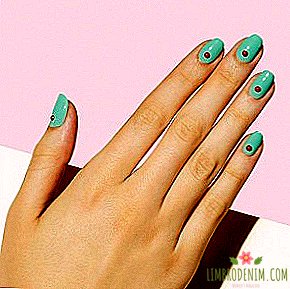Concept Stores, Palaces and Khrushchev: How Fashion interacts with Architecture
To create a unique fashion product Designers turn to a huge number of references: antique sculpture, works by Zaha Hadid or Peter Zumthor, paintings by Timur Novikov or Yves Klein, complex designs by Ai Weiwei or Lee Chen monoliths, industrial designs of the Memphis group - the list is endless. However, conceptual things and their promotion require an appropriate context: for a complete immersion of the audience and customers into the atmosphere of the collection, designers are looking for or building specially impressive sites. We tell how architecture this year has replaced the passion of fashion designers for modern art and why designers take on the role of guides on incredible buildings.

Sculpture, industrial design, architecture, fashion - all these are adjacent territories, at the junction of which religious couturiers worked during the 20th century: Charles James, Christian Dior, Paco Rabanne, Cristobal Balenciaga. Like architects, clothing designers develop a shell for a person, but, unlike the former, create an object designed to exist in motion. A vivid example of a highly controversial fashion that was defeated is the story of American couturier Charles James, whose fashion house was closed in 1958. The things of this perfectionist, though magnificently constructed, were objects of art rather than clothes, crushing a person to themselves: even by the standards of time, wearing them was like pulling a whole house on yourself. However, modern students of fashion colleges are also too fond of fantasy designs, forgetting about the utility and the sad experience of their predecessors. This is evident in the final works of Central Saint Martins, London College of Fashion, Royal College of Art.
Christian Dior, despite the severity and inconvenience of the designs of his things, still managed to make a revolution in the 1950s. He approved the new form and female silhouette, and also made the house Dior incredibly popular. "I wanted to be an architect, so as a designer, I follow the principles of architecture. When designing a dress, you take into account the laws of architecture and gravity," said Dior. Today, everything from brand boutiques to places where the new Christian Dior collections are shown echoes the approach of the founder of the fashion house. To show the autumn couture collection, a space consisting of abstract geometric stained glass windows was specially designed. The show of the cruise collection was held on the Cote d'Azur in the “Palace of Bubbles”, a surrealistic and futuristic masterpiece of 1989 by architect Antti Lovag. All in order to emphasize the spirit of the collection and the DNA of the brand. By the way, the stunning imagination of a villa with spherical porthole windows belongs today to 92-year-old Pierre Cardin, an admirer of abstract design and geometry in fashion.

Today, the show can no longer be just a show. Thanks to the impressive scenery and entertainment scenarios of the Chanel show, Karl Lagerfeld is known even to those who are far from fashion. Lagerfeld every season the city inside the Grand Palais brasserie, the supermarket. Of the architects (and not only), Karl is most interested in superstars: it is not surprising that Chanel collaborates with the main woman in world architecture Zaha Hadid. In 2008, Zach designed the mobile pavilion of Chanel, which traveled around the world from Tokyo to New York. In 2012, in order to show the spring-summer collection of Chanel, she built up the impressive snow-white decorations of the Grand Palais.
This year, Lagerfeld moved the 2016 cruise collection show to Seoul, to the bulky building of her authorship - Dongdaemun Design Plaza. It remains to wait for joint collaboration. Still, Zach is known not only for working with monumental volumes in architecture, but also for cooperation with fashion brands. Zaha is engaged in the development of design wearable gadgets, jewelry and especially shoes. Think of her metal ankle boots for United Nude, or sneakers, for Lacoste. The architect is now involved in a collaboration with adidas Originals and Farrell Williams.
Another pillar of world fashion, Louis Vuitton, collaborates with architect Frank Gehry, the very one who built the Guggenheim Museum in Bilbao, setting the fashion on the building-attractions in the 1990s. Last year, Gehry built a spectacular glass building for the Louis Vuitton foundation, and also designed the showcases of Louis Vuitton boutiques for the presentation of the debut collection by Nicolas Ghesquière, and even created a bag as part of the Icon and The Iconoclasts project. The brand continues to support the architectural approach of Hesquiera to the design of things. For the 2016 Chicken Collection, Louis Vuitton was chosen as a 1950s Art Nouveau mansion owned by the once American comedian Bob Hope and located in the Palm Springs desert in California.

Architecture and fashion, more than other forms of art, are associated with man, shaping and saturating public spaces.

Architecture and fashion, more than other forms of art, are associated with man, shaping and saturating public spaces. It is logical that these two areas harmoniously complement each other. However, the avant-garde architecture today is inferior to the more practical one - exactly the same way, the avant-garde clothes and shoes are being replaced by simple, affordable and functional ones, more corresponding to our frantic pace of life and economy. After the 2008 crisis, stellar architects are increasingly ordering mini-masterpieces - boutiques, where the organization of space and interior design must simultaneously demonstrate DNA brands and promote sales. The same Zaha Hadid builds Neil Barrett boutique in Tokyo, Norman Foster - Joseph store in London, Roksanda Ilincic orders the construction of the London flagstorm minimalist David Adjaye, the author of the Skolkovo School of Management project. Christian Dior's boutique in Seoul is designed by French postmodern architect Christian de Portzampark, who was awarded the prestigious Pritzker Prize. The building looks like flowing draperies on Christian Dior dresses.
"The first shell, the closest to the human body, is clothing. The second is the interior. The third is the building that makes up the city where the person lives. So fashion and architecture are doing about the same thing - they create for the person an environment in which comfortable. For a designer, a plan is a human body, its proportions. He, like the architect, comes up with a new envelope, a new visual aesthetics. Moreover, clothing, like architecture, can influence a person’s psychological state. For example, it can provide a sense of security from weather conditions to In the song of the group “SPBCH” - “when you put on a hood and it becomes easier”, ”Galya Chepkina, founder of the Moscow brand Gaito, shares.

Another striking example of the interaction of fashion with architecture is Prada’s ten-year collaboration with Rem Koolhaas, the founder of the OMA architectural bureau, who designed the new building of the Garage. Kolahas is responsible for almost every Prada show, both male and female, as well as Miu Miu. For the show, the architect builds empty pavilions from scratch, turning them into a nightclub in the spirit of the 1990s, then into an "ideal house" or a swimming pool. Kolkhas and Prada collaborate on larger projects. In 2009, OMA built an impressive transformer boutique for Prada in Seoul, and recently completed the Prada Foundation Art Center in Milan. The Kolkhas bureau has turned an old distillery into a new art center, combining the old and the new. The art center of the Prada Foundation is an example of how modern architecture has taken a course towards democratization and decentralization, well-thought and modest buildings, and respect for the land and already existing buildings.
For fashion houses today, the logical stage of development is the use of the environment, fashion enters into an alliance with urbanism, computer modeling. Stamps are actively taken for the development of urban spaces and buildings. This year, for the presentation of the 2016 cruise collection, Gucci selected the background of almost the most emblematic urban landscape of the 20th century - the architecture of New York, leading models to 10th and 11th avenues. Thus, Gucci showed how bold styling Alessandro Michele will look on the streets of one of the most dynamic cities of our time. Of course, the thought “fashion comes from the streets and returns to the streets” is not new. It is enough to recall the street shows of the group "Buffalo" of the 80s, Chloe Sevigny on the streets of Soho at the X-Girl show of the mid-90s and the show of Marc Jacobs. But even today, one wants to see clothes on ordinary streets rather than against the background of conceptually twisted glass and concrete.

The organizers of the Florence exhibition Pitti Uomo found the perfect way to interact with architecture. And we are talking about the whole city. Stamps master the ancient Italian courtyards, lush gardens, baroque palazzo. So, Ports 1961 this year presented a new men's collection right on the streets of Florence, on Onisanti Square. Moschino climbed into the baroque rooms of the old 17th century Palazzo Corsini. Kilgour showed things in the Medici family palace in the center of Florence. “With the help of fabric, I work on body architecture. Shape, functionality, plus correct geometry is the key to creating clothes,” says Kilgour creative director Carlo Brandelli, who started as a sculptor. “Architecture creates the environment in which you have to live. . Hence, the minimalistic format of the presentation: a transparent glass labyrinth was placed in the baroque decoration of the Medici Palace, where a man stood alone in a perfectly tailored Kilgour costume.
Another example is the presentation of the prodigy from Canada, designer Thomas Tate at Pitti Uomo, who received a grant a year ago from the largest fashion company LVMH. Thomas, who is close to the architectural design of things, collaborated with the architect Mehrnush Hadwi. Together, they built a mirror corridor in the Boboli gardens, where LED earrings, surreal boots, the thinnest tops and coarse jackets literally floated in the air. Behind Hadwi - work on the New York boutique Nicholas Kirkwood. The place for Tate’s presentation was partly reminiscent of the minimalist space of the boutique and at the same time the exhibition, where attention was focused on the things of difficult tailor work. In fact, it turned out the perfect format for a young brand, which shows an incredible quality of performance of things. Tate wanted people to look at each thing closely and touch it.

Impressive showplaces complement the mythology of things told and shown in detail.

Impressive places show complements the mythology of things, told and shown in detail. The creators of progressive Russian brands also understand this: first of all, Rubchinsky’s show comes to mind at the stadium in Sokolniki and in the church at Baumanskaya, as well as the Walk of Shame shows in the Summer House of Count Orlov in Neskuchny Garden and the constructivist building of the Central House of Artists. At the same time, the faceless long podium at the Manezh or Gostiny Dvor at the Russian Fashion Week with a parade of different brands does not want to be remembered: it is obvious that the organizers thought about interaction with the historical space as the last thing, perceiving it only as square meters.
"Architecture and fashion all the time interact with the body. Fashion is in direct contact, architecture absorbs a person into their spaces. In both cases, they determine the person’s sense of self, mood, liberation or suppression. These are inseparable concepts in fact. As soon as you buy a new dress, You urgently need a great space for it. Finished the renovation - updated the wardrobe, "says young Russian designer Alisa Kuzembaeva. Alice has an architect diploma." Every day we do what we compare GUSTs and our wardrobe when going out of the house. " Indeed, clothing cannot be perceived separately from the medium in which it is worn.

At Bauhaus School, it was believed that unusual spaces change communication between people and that thanks to these buildings, society will become more progressive and more humane in the future. In part, fashion can also be given such a mission. We instinctively strive for harmony, no matter how the ideas about it change over time - both the buildings and the clothes that the people who inhabit them wear create a visible but not always conscious cocoon around us. As a result, both can transform the urban environment for the better, and make it aggressive and unfriendly. That is why designers, who are at times too eager to achieve globalism or universality, should always remember about the environment in which their clothes will live and be worn. That is why the street Italian fashion will always be different from the Russian, and the Russian - from the American or Japanese. After all, whatever one may say, baroque gold would be best to look in the "curly" palazzo, while Moscow constructivism and the Khrushchev so beautiful beautiful sneakers, comfortable workouts and dresses of rigid forms are perfect.
Photo: Shutterstock, (Courtesy of Pierre Cardin), (Courtesy of Dior), indigitalitalia.com/Pitti Uomo, AKAstudio-collective / Pitti Uomo





